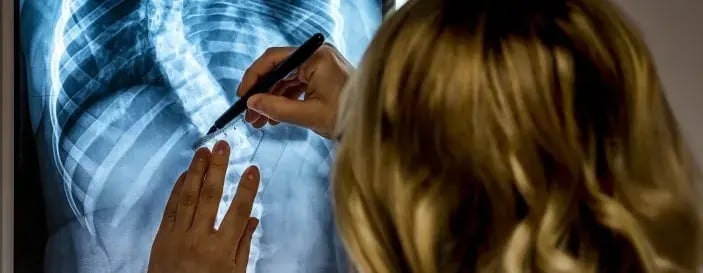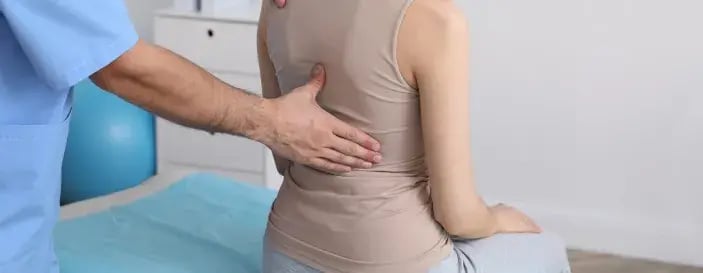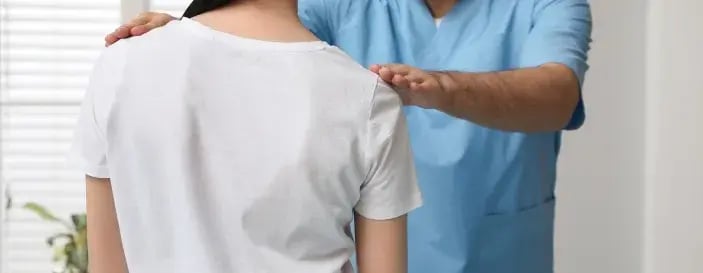Do you know someone with a curved spine? Scoliosis, a condition impacting millions globally, often goes unnoticed until physical symptoms emerge. From uneven shoulders to a tilted posture, scoliosis can affect physical appearance and, in severe cases, overall health. By understanding its causes, symptoms, and treatment options, we can offer support and insight to those affected. Here, we explore what scoliosis is, what causes it, how it presents, and the treatment pathways available, including non-operative and surgical approaches.

What Is Scoliosis?
Scoliosis is a condition where the spine curves abnormally, forming an "S" or "C" shape instead of running straight down the back. It’s important to note that scoliosis is not a disease but a physical deformity that varies significantly in severity. While mild cases may barely be noticeable, more severe cases can result in significant deformities and even pain.
The majority of scoliosis cases are idiopathic – meaning the cause is unknown – but factors such as genetics, muscle imbalances, or underlying neurological conditions can contribute to its development. Scoliosis is a condition that can affect people of all ages, from children to the elderly, and often requires regular monitoring to ensure it doesn’t progress.
What Causes Scoliosis?
Identifying the cause of scoliosis can be challenging, as it often results from a combination of factors. Key contributors include:
- Genetics: Scoliosis often runs in families, although specific genes responsible remain unidentified.
- Neuromuscular Disorders: Conditions such as cerebral palsy or muscular dystrophy can disrupt muscle and nerve function, leading to spinal curvature.
- Congenital Defects and Injuries: Scoliosis can develop due to spinal abnormalities present at birth or traumatic events that damage the spinal structure.
Understanding the potential triggers allows medical professionals to better tailor treatments and intervention plans to the individual.

Symptoms and Appearance of Scoliosis
The symptoms and physical presentation of scoliosis vary widely. Common signs include:
- Uneven shoulders or asymmetrical posture.
- A rib hump visible on one side when the person bends forward.
- A shifted waistline or imbalance in hip alignment.
Beyond physical appearance, scoliosis may also cause discomfort, muscle fatigue, and reduced lung function in severe cases. For many, the aesthetic aspect of scoliosis significantly impacts self-confidence, highlighting the importance of compassionate care and timely treatment.

Non-Operative Treatment
When it comes to managing mild to moderate cases of scoliosis, non-operative approaches are often the first line of care. A key component of such treatment is bracing:
- Bracing and Physical Therapy
A well-designed brace programme is essential to prevent curvature progression, particularly in growing adolescents. Combined with targeted physical therapy, bracing supports spinal alignment while improving muscle strength and mobility.
Bracing is evidence-based and proven effective when used as part of a formal treatment plan. It’s particularly beneficial in cases where population screening has detected early-stage scoliosis.
Surgical Treatment
For individuals with severe scoliosis, where the spinal curve exceeds a certain threshold, surgery may be necessary to correct the deformity and prevent complications. Modern scoliosis surgery has advanced significantly, integrating sophisticated technologies to enhance safety and outcomes.
Key Technologies in Scoliosis Surgery
- Computer Navigation: Acting as a "super eye," this technology allows surgeons to visualise and guide the placement of spinal implants with exceptional precision, reducing risks of misalignment and complications.
- Intra-Operative Neuromonitoring: This innovation ensures continuous monitoring of spinal cord function during surgery, providing real-time feedback and added safety.
The primary goals of surgery are to straighten the spine, achieve balance, and stop the curve from worsening. While some risks – such as infection or nerve damage – exist, advancements in techniques have drastically improved results, with many patients experiencing life-changing benefits.

Post-Surgical Recovery
The recovery process following scoliosis surgery is both critical and rewarding. Initially, patients typically stay in hospital for a monitored period, where pain management and wound care are prioritised. Physical therapy begins early to encourage mobility and set the foundation for long-term recovery.
At home, recovery involves a gradual return to everyday activities under medical guidance. Physical therapy continues to play a major role in restoring strength and flexibility, enabling patients to resume their lifestyle with improved posture and reduced discomfort.
Though scoliosis surgery carries physical and emotional challenges, the outcomes are overwhelmingly positive, especially when care is tailored to the individual’s needs.